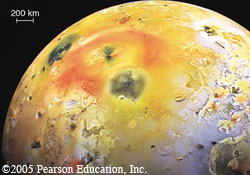
The Galilean Moons of JupiterThe Galilean Moons of Jupiter
Summary: Jupiter has more than 60 known moons, but understanding the geology of its four largest will hopefully lead to some groundbreaking discoveries.
The Galilean Moons
Io: Volcanoes and all
Europa: What lies beneath?
Ganymede: Largest moon in the solar system
Callisto: The outermost Galilean moon
Related Lessons:
The Moons of Jupiter
The Jovian Basketball Hoop
The Jovian System: A Scale Model
Strange New Planet
The Galilean Moons
Each of the Jovian planets has a number of moons, although Jupiter has the most with more than 60 catalogued to date. Jupiter's 4 largest moons exhibit some of the most interesting geology in the solar system. They were discovered by Galileo Galilei and are known as the Galilean moons. Jupiter's largest moon, Ganymede, is larger than Mercury while the other three are larger than Pluto.
Outward from Jupiter:
- Io
- Europa
- Ganymede
- Callisto

The Galilean Moons of Jupiter
Io: Volcanoes and All

Jupiter's Moon Io
The Voyager spacecraft took the first close-up images of Io more than 300 years after the moon's discovery. The images showed a surface with no signs of craters from past impacts. What we saw instead was a surface almost entirely covered with large volcanoes. Cameras on Voyager actually captured volcanic eruptions in progress. The frequency of these sulfuric eruptions has filled in almost all of the impact craters and left Io with one of the youngest looking surfaces in the solar system.
Close-up photos of eruptions in progress show powerfully hot lava glowing orange and red. Photos taken on the night side of Io show not only the hot volcanic vents, but also a thin sulfur dioxide atmosphere produced by constant outgassing. Io's unusual red and orange colors come primarily from sulfur, which condenses on the surface after being outgassed by the volcanoes.
Although there is no direct evidence of tectonic activity on Io, scientists feel confident it exists since the processes that fuel volcanism also fuel tectonics. The volcanic eruptions are so frequent and cover the surface so thoroughly that any clear evidence of tectonic activity is likely to be buried.
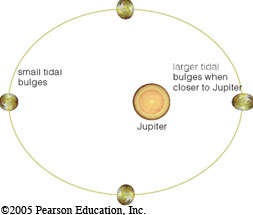
Io's Tidal Bulging
The bulges and orbital eccentricity
are exaggerated in this diagram.
Tidal Heating
Io's activity is generated by heat deep inside its center. The force needed to keep Io in synchronous rotation with Jupiter creates bulges on Io just like the Moon creates the ocean tides on Earth. The constant change in size and orientation of Io causes friction that creates enough internal heat for volcanic eruptions to occur.
Click to learn more about synchronous rotation and tidal heating.

Io's Elliptical Orbit
Io's Elliptical Orbit
Ganymede, Europa and Io are all in orbital resonance with Jupiter. Io completes exactly four orbits and Europa completes exactly two orbits in the same time it takes Ganymede to complete one orbit around Jupiter. During the course of their orbits, the three moons line up like in the picture seen to the left. Since they periodically line up in this fashion, the gravitational tugs the moons exert on each other stretch their orbits into elliptical shapes.
Europa: What Lies Beneath?

Europa
Europa's surface and crust are made almost entirely of water ice, and its bizarre, fractured appearance is proof enough that tidal heating has acted there. The icy surface is nearly devoid of impact craters and may be only a few million years old.
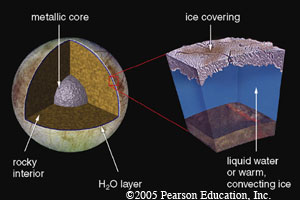
Europa's Interior
Observations made by the Galileo spacecraft show that Europa has a metallic core and a rocky mantle. Surrounding the rocky interior appears to be an icy layer 100 kilometers thick, the top few kilometers of which seem to be frozen solid. The stretching and squeezing of tidal friction should provide enough heat to melt some of this into liquid water beneath a thin ice shell. If it does, then Europa may have an ocean with more than twice as much liquid water as all of Earth's oceans combined.
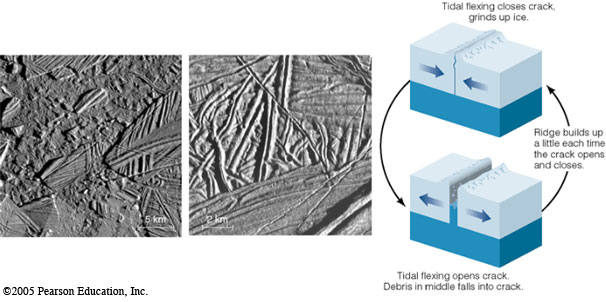
Analyzing Europa's Cracked Surface
Close-up photos of the surface of Europa support the idea of a liquid ocean beneath the surface. These photos, taken by the Galileo spacecraft, show what appears to be icebergs stuck in a layer of ice. Other evidence comes from double-ridged cracks on the surface. Tidal flexing that allows water to well up and build ridges may create these cracks.
Ganymede: Largest Moon in the Solar System
The surface of Ganymede shares many similarities with Europa. Ganymede's surface is also made of water ice, but unlike Europa's surface, it shows signs of varying age. The darker regions are heavily cratered, suggesting they are billions of years old. The lighter regions show no signs of craters and it is thought that eruptions of water covered the surface before freezing over. These areas are geologically younger than the darker regions.
If liquid water occasionally makes its way to the surface to fill in craters, could that suggest a liquid ocean similar to the one that might exist on Europa?
Not necessarily. The case for Europa's subsurface ocean comes from the strong probability of tidal heating, melting the ice under the surface. Ganymede has a much weaker tidal force, and thus weaker tidal heating than Europa and Io. The level of Ganymede's tidal heating could not provide enough heat to make an ocean of liquid water. Aside from tidal heating, we are not sure where sufficient heat would come from to melt the ice.
Callisto: The Outermost Galilean Moon
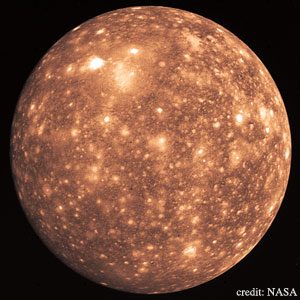
Callisto
Callisto is the stereotypical outer solar system satellite. It is one of the largest and most heavily cratered satellites in the solar system. The surface is very icy and dates back four billion years. Beneath the icy crust is possibly a salty ocean supported by a deeper rocky interior.
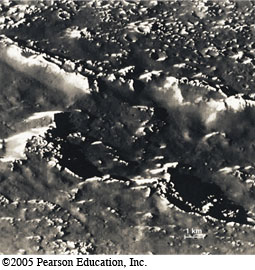
Callisto's Surface
Callisto doesn't have any large mountains, show evidence of volcanic or tectonic activity or have any appreciable level of internal heat. Nonetheless, observations of Callisto's magnetic field may cause scientists to add the large moon to the list of possible worlds with subsurface salty oceans.

